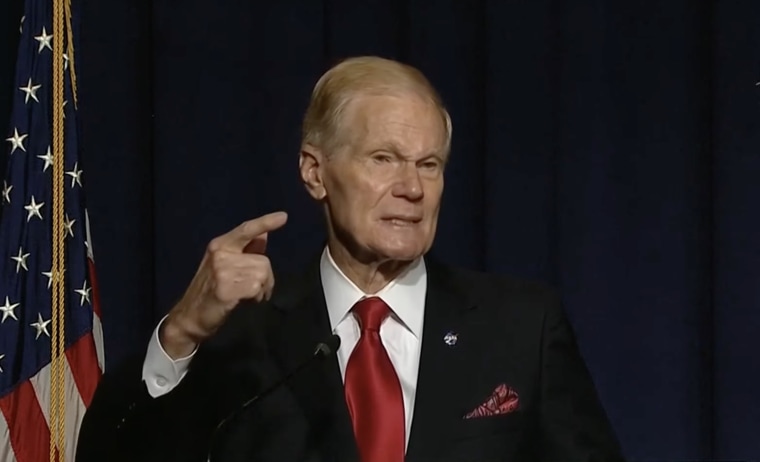 NASA Administrator Bill Nelson. Still from “Live: Nasa experts discuss recent findings of UFO study” via Independent/YouTube (see below).
NASA Administrator Bill Nelson. Still from “Live: Nasa experts discuss recent findings of UFO study” via Independent/YouTube (see below).
Researchers at the National Aeronautics and Space Administration have shared NASA’s first-ever report on unidentified aerial phenomena (UAP) — historically referred to as unidentified flying objects (UFOs). A panel of Bill Nelson (NASA’s Administrator) and three NASA research heads briefly summarized their findings this morning and answered questions from members of the press.
Nelson spoke first, relating the mission of the study in broad strokes and expressing his personal belief that (to paraphrase) aliens exist. “If you ask me, do I believe there’s life in a universe that is so vast that it’s hard for me to comprehend how big it is, my personal answer is yes,” he said. “But I asked some of our scientists… ‘What is the mathematical probability that there is life out there in the universe?’ And if you calculate — in billions of stars, in billions of galaxies — that there is… another stony planet [with habitable conditions for life], the answer was… at least a trillion.” (One can assume Nelson means that at least a trillion such planets likely exist, not that the likelihood of extraterrestrial life is a trillion percent.)
Next was Dr. Nicola Fox, the head of NASA’s science mission directorate. In the intro to the UFO report, Fox writes the following: “Observations of objects in our skies that cannot be identified as balloons, aircraft, or natural known phenomena have been spotted worldwide, yet there are limited high-quality observations. The nature of science is to explore the unknown, and data is the language scientists use to discover our universe’s secrets. Despite numerous accounts and visuals, the absence of consistent, detailed, and curated observations means we do not presently have the body of data needed to make definitive, scientific conclusions about UAP.” (In other words, we don’t know what’s out there, not even a little bit.)
She was followed by her Assistant Deputy Associate Administrator for Research, Daniel Evans, who spoke quickly about one of the study’s more functional aims: to determine whether UAP pose a risk to airspace safety. “Let’s not forget that the first ‘A’ in NASA is Aeronautics,” he reminded the crowd of journalists, “so by understanding the nature of UAP, we can ensure that our skies remain a safe space for all.”
The panel’s final speaker was Dr. David Spergel, President of the Simons Foundation and Chair of NASA’s UAP Independent Study Team, who emphasized that there is no definitive evidence, as of yet, of alien life in Earth’s airspace. “It is essential to clarify, based on our current findings and methodology, that we find no evidence to suggest that UAP are extraterrestrial in nature,” he said. “Our focus is on understanding the phenomena, however, regardless of the source.”
Spergel also touched on the potential use of AI in NASA’s mission to build a more robust dataset of UAP images and recordings. When the panel was asked by a BBC News reporter how government regulations on AI might hamper their work, Nelson responded that, while he believes AI must have boundaries “for our existentialism,” he’s confident that NASA can make use of the technology for their research “within those bounds.”
When asked about the stigma of UFO sightings as the stuff of urban legend, the panel revealed that they had all received harassment on social media surrounding their UFO research and that, for that reason, NASA would not be publicly naming their newly appointed Director of UAP Research.
Later in the discussion, the panel responded to another BBC News reporter who asked about the recent presentation of two alleged “alien corpses” to the Mexican Congress, which prompted strong reactions on all sides of the discourse and generated a legion of bad memes. “We don’t know the nature of those samples,” Spergel said. “My recommendation [to the Mexican government] is, if you have something strange, make samples available to the world scientific community, and we’ll see what’s there.”
Watch the full press conference below, via Independent.